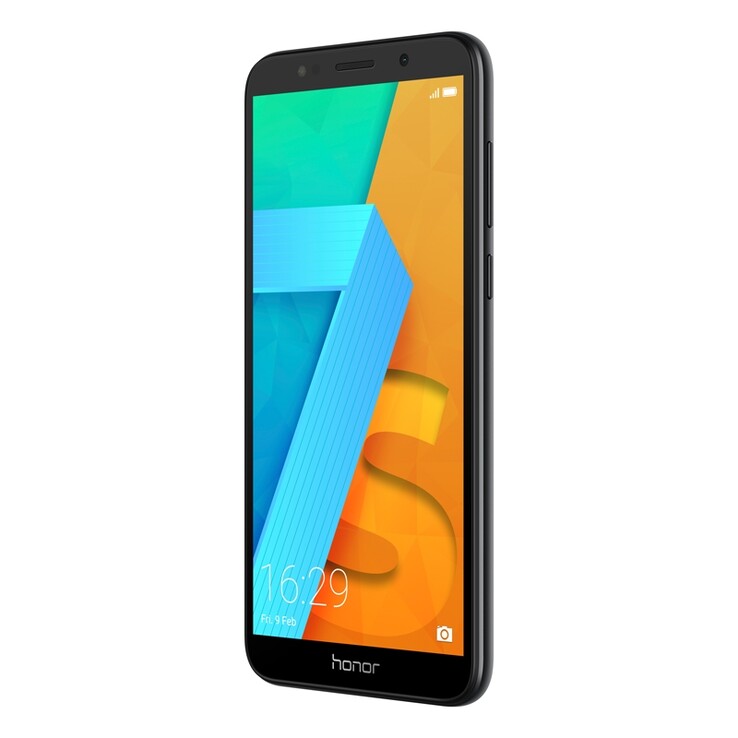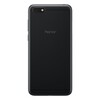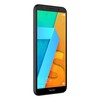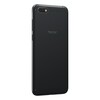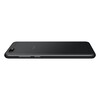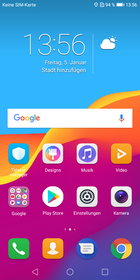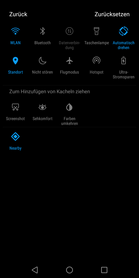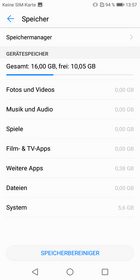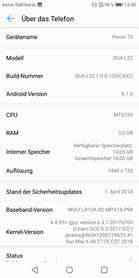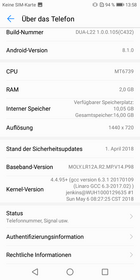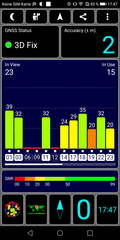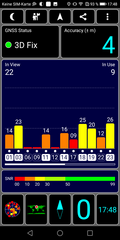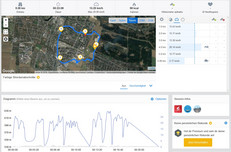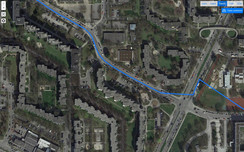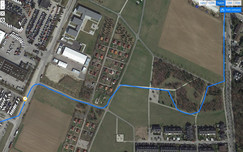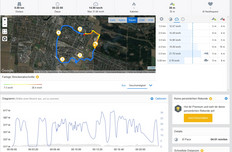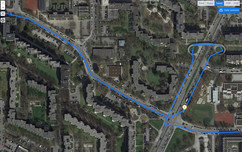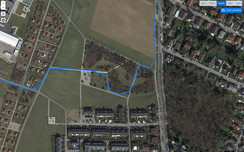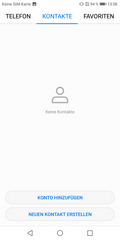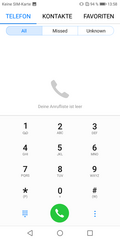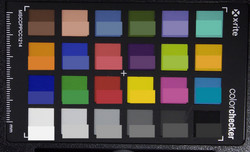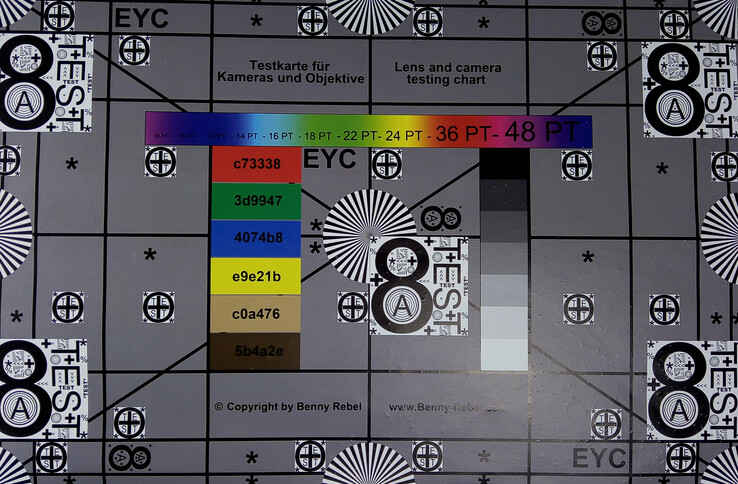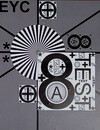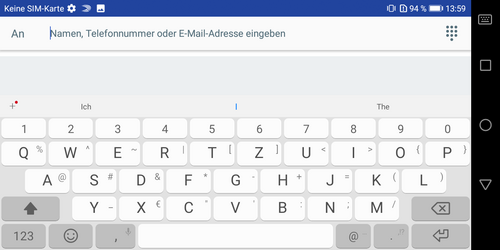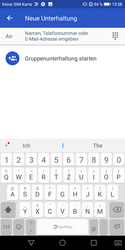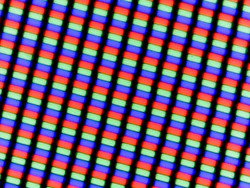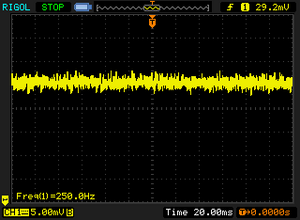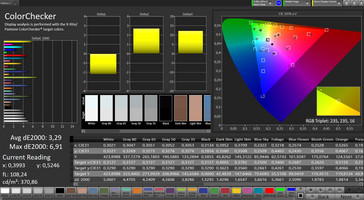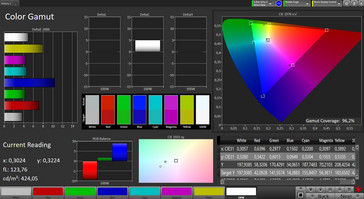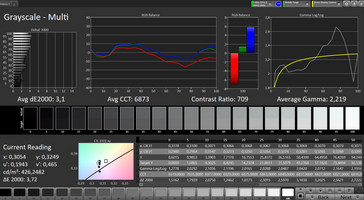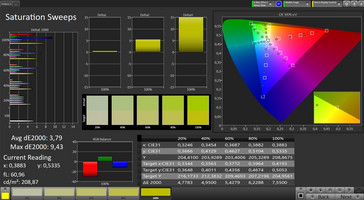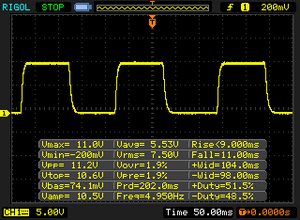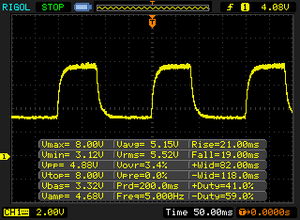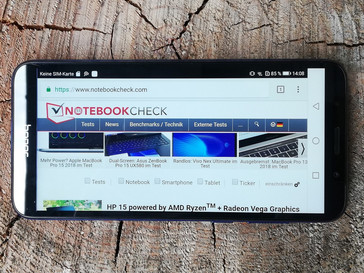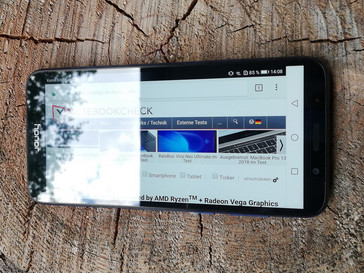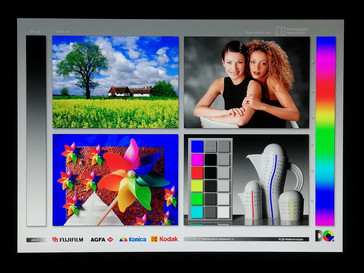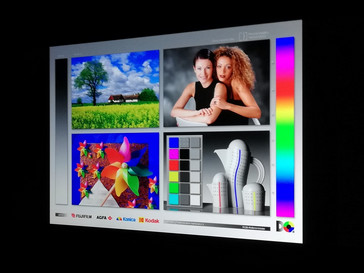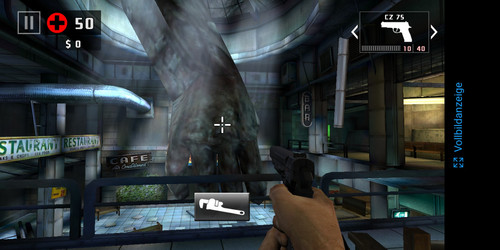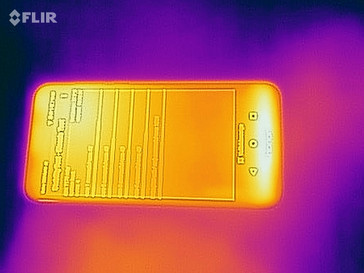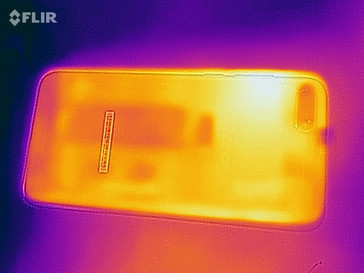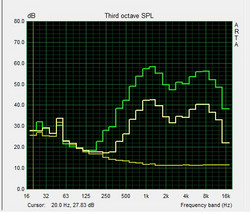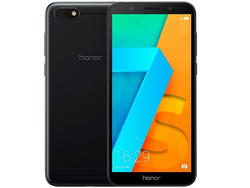Honor 7S Smartphone Review

We have already reviewed several smartphones made by Honor. Whether entry-level or mid-range smartphones, all devices have one thing in common: A comparatively low price. The Honor 7S gives prospective buyers the opportunity to purchase an Android Oreo device for 120 Euros (~$140). In exchange, users will get a smartphone with a Mediatek MT6739 SoC, a PowerVR GE8100 graphics unit, 2 GB of RAM and 16 GB of eMMC flash storage.
This price bracket is thronged with competitors, including the Honor 7A from the same manufacturer. For the purposes of this review, we will also compare the Honor 7C with the Xiaomi Redmi Note 5A, Umidigi's A1 Pro and Huawei's Y5 (2018).
Case - Robust design for the Honor 7S
The Honor 7S's case is constructed of plastic and is available in the colors black, blue and gold. The back of the smartphone is embellished with tiny notches. The manufacturing quality is very solid and gives you the sense that the smartphone is quite robust. The transitions between the back and the display are even, and the physical buttons and SIM/SD card slots sit securely in their respective spots.
At just 142 gram (0.31 lb), the Honor 7S is the most lightweight device in our comparison list. The rest of the body measurements are commonplace for a 5.45-inch device in this price bracket.
Connectivity - Entry-level smartphone from Honor
Honor has chosen to equip the 7S with a Mediatek MT6739 SoC, a PowerVR GE8100 graphics unit, two GB of RAM and 16 GB of eMMC flash storage. This hardware configuration is appropriate for an entry-level smartphone and should enable the system to run smoothly. Even so, this hardware is primarily suited for simple applications.
The Honor 7S can be charged via the microUSB connection, or the port can be used to transfer data according to the USB 2.0 standard. The SIM card slot enables the owner to use two nano SIM cards and one microSD card simultaneously. The 3.5 mm jack makes it possible to physically connect an external headset or speakers to the Honor 7S.
Software - Huawei UI on the Honor smartphone
The Honor 7S comes with Android 8.1.0 with security updates dated from April 1st, 2018, as well as Huawei's EMUI 8.1 user interface. These software items are similar in structure to pure Android, though the settings menu is organized differently. The phone comes with very few third-party apps pre-installed, and those that are present can be easily uninstalled in the app menu. Additionally, it is possible to open multiple user accounts on the Honor 7S.
A microSD card can add up to 256 GB worth of storage space. The standard storage location can only be changed from the internal storage to the microSD card in the settings menu. Apps that have already been installed cannot be moved, nor can the memory card be reformatted as internal storage.
Communication and GPS - Honor 7S with GPS glitches
The Honor 7S smartphone can establish wireless connections via GSM, 3G and LTE (Cat. 4). The latter enables data transfer rates of up to 150 MBit/s downloading and up to 50 MBit/s uploading. Users can rely on WLAN standards b/g/n and Bluetooth 4.2 for communication over shorter distances.
In our tests, the Honor 7S achieved data transfer rates over WLAN appropriate to the smartphone's hardware configuration and price bracket. As a result, the competitors are more or less on par with our test device here, though the Honor 7S takes first place by a slim margin.
| Networking | |
| iperf3 transmit AX12 | |
| Honor 7S | |
| Xiaomi Redmi Note 5A Prime | |
| Umidigi A1 Pro | |
| Huawei Y5 2018 | |
| Honor 7A | |
| iperf3 receive AX12 | |
| Honor 7S | |
| Umidigi A1 Pro | |
| Xiaomi Redmi Note 5A Prime | |
| Huawei Y5 2018 | |
| Honor 7A | |
We used the GPS Test app to determine how accurately the Honor 7S could position us. The budget smartphone ascertained its position outdoors with an accuracy of up to 2 meters (~7 feet), and even indoors the accuracy held at 4 meters (~13 feet).
After taking these base accuracy measurements, we used our Garmin Edge 520 reference device to determine how well the Honor 7S performs in terms of navigation. On our obligatory bike ride, the Honor 7S's GPS could keep pace with the Garmin Edge 520 - but large sections of the recorded path were missing. This could cause problems for users even during simple navigation tasks.
Phone Function and Call Quality - Budget smartphone with LTE
Users of the Honor 7S have access to Huawei's own phone app. With direct access to Contacts and Favorites, the functionality of this app is comparable to that of Google's standard Android phone app.
During conversations, participants are easy to understand, though the earphone's volume is comparatively low. Even small amounts of background noise make it difficult to understand everything the person on the other end is saying. The speakerphone function does not help here either and is only fit for use in very quiet environments.
Using a headset is a far better experience. The volume can be turned up much higher, making it easier to understand the person on the other end.
Cameras - Honor smartphone for the occasional snapshot
Honor has chosen to equip the 7S with a 13 MP main camera and a 5 MP front camera. The latter takes reasonably good selfie shots in normal daylight conditions indoors. As long as the object of the shot remains in the fixed focus's field, it is possible to take sharp photos. Objects outside of the focus area and in the background, on the other hand, become increasingly blurry.
The 13 MP main camera is good for the occasional snapshot. Panorama shots are average quality, but upon close observation we see that object boundaries are not well-defined. Light and dark areas of an image, on the other hand, are clearly distinguished from each other - although within dark areas differences in color are only just recognizable. In very good ambient light, close-ups also look good, but object boundaries are not well-defined here either.
It is impossible to take good photos in low light. The Honor 7S's light sensitivity is sufficient to capture all the objects in the scene, but the result is a blurry photo in which the original motif is just barely recognizable. Video recordings taken with the Honor 7S are saddled with the same limitations and require a steady hand. The smartphone is equipped with an image stabilizer, but it only corrects for minor camera shake.
We used the ColorChecker Passport program to test the color accuracy of the Honor 7S's camera. Here we see that almost every color is rendered too darkly. This effect is less obtrusive for yellow and green mixed tones.
In a controlled lighting environment, the Honor 7S was able to take a quality snapshot of our test chart. The camera's tendency to render colors too darkly is visible here, and object borders are a little blurry, but the imperfections are only noticeable up close.
Accessories and Warranty - 24 months of warranty coverage from Honor
The Honor 7S's box contents consist of just a USB power supply with matching microUSB cable and a SIM ejector tool. Users will have to turn to a third-party manufacturer for accessories tailored to the Honor 7S. Universal smartphone accessories such as power banks, headsets and selfie sticks are available directly from Honor.
Buyers of the Honor 7S will receive a 24-month warranty. Please see our Guarantees, Return policies and Warranties FAQ for country-specific information.
Input Devices and Operation - Swift Key on the Honor smartphone
Honor has installed the keyboard app "Swift Key" on the 7S. This keyboard enables users to type texts quickly and easily. It also offers a variety of customization options, such as skins. Our test device's touchscreen reacts to input quickly and reliably, although the level of friction between the screen and the user's fingertips is a little too high. This is problematic primarily during the execution of drag-and-drop and swipe gestures. In addition, the position sensor reacts very slowly.
Display
Honor chose to equip the 7S with a 5.45-inch IPS panel. This panel has a resolution of 1440x720 pixels and an average brightness level of around 417 cd/m². Compared to other smartphone in this price bracket, the 7S's brightness is a little below average.
In our list of devices for comparison, the Honor smartphone takes next-to-last place in terms of brightness. In addition, Honor used PWM to regulate the display brightness. At brightness levels of less than 25 percent, the display flickers at a frequency of 250 Hz.
| |||||||||||||||||||||||||
Brightness Distribution: 96 %
Center on Battery: 422 cd/m²
Contrast: 728:1 (Black: 0.58 cd/m²)
ΔE ColorChecker Calman: 3.29 | ∀{0.5-29.43 Ø4.77}
ΔE Greyscale Calman: 3.1 | ∀{0.09-98 Ø5}
96.2% sRGB (Calman 2D)
Gamma: 2.219
CCT: 6873 K
| Honor 7S IPS, 1440x720, 5.5" | Xiaomi Redmi Note 5A Prime IPS, 1280x720, 5.5" | Umidigi A1 Pro IPS, 1440x720, 5.5" | Huawei Y5 2018 IPS, 1440x720, 5.5" | Honor 7A IPS, 1440x720, 5.7" | |
|---|---|---|---|---|---|
| Screen | 6% | 0% | -83% | 4% | |
| Brightness middle (cd/m²) | 422 | 469 11% | 594 41% | 475 13% | 417 -1% |
| Brightness (cd/m²) | 417 | 464 11% | 570 37% | 470 13% | 395 -5% |
| Brightness Distribution (%) | 96 | 92 -4% | 86 -10% | 91 -5% | 88 -8% |
| Black Level * (cd/m²) | 0.58 | 0.6 -3% | 0.22 62% | 0.76 -31% | 0.18 69% |
| Contrast (:1) | 728 | 782 7% | 2700 271% | 625 -14% | 2317 218% |
| Colorchecker dE 2000 * | 3.29 | 3.31 -1% | 6.63 -102% | 9.12 -177% | 6.46 -96% |
| Colorchecker dE 2000 max. * | 6.91 | 6.68 3% | 13.99 -102% | 18.86 -173% | 10.72 -55% |
| Greyscale dE 2000 * | 3.1 | 2.4 23% | 9.2 -197% | 12 -287% | 5.8 -87% |
| Gamma | 2.219 99% | 2.155 102% | 2.24 98% | 2.342 94% | 2.423 91% |
| CCT | 6873 95% | 6626 98% | 8663 75% | 9861 66% | 7839 83% |
* ... smaller is better
Screen Flickering / PWM (Pulse-Width Modulation)
| Screen flickering / PWM detected | 250 Hz | ≤ 20 % brightness setting | |
The display backlight flickers at 250 Hz (worst case, e.g., utilizing PWM) Flickering detected at a brightness setting of 20 % and below. There should be no flickering or PWM above this brightness setting. The frequency of 250 Hz is relatively low, so sensitive users will likely notice flickering and experience eyestrain at the stated brightness setting and below. In comparison: 53 % of all tested devices do not use PWM to dim the display. If PWM was detected, an average of 8081 (minimum: 5 - maximum: 343500) Hz was measured. | |||
At 728:1, our test device's contrast ratio is comparatively low, but some similarly priced devices have contrast ratios that are even lower. The Honor 7A and the Umidigi A1 Pro prove that inexpensive devices can do better here. The Honor 7S's black value of 0.58 is high, but the same caveat applies as in the discipline of contrast ratio. In our CalMAN measurements, we found that the display has a significant blue cast.
Display Response Times
| ↔ Response Time Black to White | ||
|---|---|---|
| 20 ms ... rise ↗ and fall ↘ combined | ↗ 9 ms rise | |
| ↘ 11 ms fall | ||
| The screen shows good response rates in our tests, but may be too slow for competitive gamers. In comparison, all tested devices range from 0.1 (minimum) to 240 (maximum) ms. » 42 % of all devices are better. This means that the measured response time is similar to the average of all tested devices (20.2 ms). | ||
| ↔ Response Time 50% Grey to 80% Grey | ||
| 40 ms ... rise ↗ and fall ↘ combined | ↗ 21 ms rise | |
| ↘ 19 ms fall | ||
| The screen shows slow response rates in our tests and will be unsatisfactory for gamers. In comparison, all tested devices range from 0.165 (minimum) to 636 (maximum) ms. » 60 % of all devices are better. This means that the measured response time is worse than the average of all tested devices (31.6 ms). | ||
The Honor 7S can be used outdoors without a problem, as long as users give preference to shady spots and look at the display from a direct angle. In direct sunlight, the display content is difficult to see. The view can also be obscured by reflections from objects in the surrounding environment, which makes it even harder to use the smartphone.
The Honor 7S's IPS panel has very stable viewing angles. This means that the smartphone's display content always looks correct, even from less than ideal vantage points. Especially outdoors, however, mirrored objects and surface reflections can obstruct the user's view of the screen content.
Performance - Honor smartphone for simple tasks
Honor has chosen to equip the 7S with Mediatek's entry-level MT6739 SoC and a PowerVR GE8100 graphics unit. The two processors are joined by 2 GB of RAM and 16 GB of internal eMMC flash storage. These hardware components are often found in budget entry-level smartphones and can run both Android Oreo and simple apps.
In our benchmarks, the Honor 7S's performance proves to be comparatively low. In almost every test, our test device takes one of the bottom rungs. In everyday use, time and again the phone needs a little time to load, including opening the settings menu, for example.
| AnTuTu v6 - Total Score (sort by value) | |
| Xiaomi Redmi Note 5A Prime | |
| Umidigi A1 Pro | |
| Huawei Y5 2018 | |
| Honor 7A | |
| Average Mediatek MT6739 (25012 - 38060, n=13) | |
| AnTuTu v7 - Total Score (sort by value) | |
| Honor 7S | |
| Xiaomi Redmi Note 5A Prime | |
| Umidigi A1 Pro | |
| Huawei Y5 2018 | |
| Honor 7A | |
| Average Mediatek MT6739 (26874 - 46951, n=13) | |
| PCMark for Android | |
| Work performance score (sort by value) | |
| Honor 7S | |
| Xiaomi Redmi Note 5A Prime | |
| Umidigi A1 Pro | |
| Huawei Y5 2018 | |
| Honor 7A | |
| Average Mediatek MT6739 (3742 - 5136, n=11) | |
| Work 2.0 performance score (sort by value) | |
| Honor 7S | |
| Xiaomi Redmi Note 5A Prime | |
| Umidigi A1 Pro | |
| Huawei Y5 2018 | |
| Honor 7A | |
| Average Mediatek MT6739 (2467 - 5377, n=16) | |
| GFXBench 3.0 | |
| on screen Manhattan Onscreen OGL (sort by value) | |
| Honor 7S | |
| Xiaomi Redmi Note 5A Prime | |
| Umidigi A1 Pro | |
| Huawei Y5 2018 | |
| Honor 7A | |
| Average Mediatek MT6739 (4.4 - 10, n=16) | |
| Average of class Smartphone (18 - 166, n=155, last 2 years) | |
| 1920x1080 1080p Manhattan Offscreen (sort by value) | |
| Honor 7S | |
| Xiaomi Redmi Note 5A Prime | |
| Umidigi A1 Pro | |
| Huawei Y5 2018 | |
| Honor 7A | |
| Average Mediatek MT6739 (2.2 - 2.8, n=14) | |
| Average of class Smartphone (12 - 606, n=154, last 2 years) | |
| GFXBench 3.1 | |
| on screen Manhattan ES 3.1 Onscreen (sort by value) | |
| Honor 7S | |
| Xiaomi Redmi Note 5A Prime | |
| Umidigi A1 Pro | |
| Huawei Y5 2018 | |
| Honor 7A | |
| Average Mediatek MT6739 (2.6 - 6.7, n=16) | |
| Average of class Smartphone (11 - 166, n=155, last 2 years) | |
| 1920x1080 Manhattan ES 3.1 Offscreen (sort by value) | |
| Honor 7S | |
| Xiaomi Redmi Note 5A Prime | |
| Umidigi A1 Pro | |
| Huawei Y5 2018 | |
| Honor 7A | |
| Average Mediatek MT6739 (1.3 - 1.7, n=16) | |
| Average of class Smartphone (8.4 - 413, n=154, last 2 years) | |
Our test device comes in near the bottom in the browser benchmarks as well. Both in JetStream 1.1 and Octave V2, as well as in Mozilla's Kraken 1.1, the Honor 7S performs below average. In everyday use, however, surfing goes smoothly and websites load quickly. Only media content needs somewhat longer to load.
| JetStream 1.1 - Total Score | |
| Honor 7A (Chrome 67) | |
| Umidigi A1 Pro (Chrome 66) | |
| Huawei Y5 2018 (Chrome 67) | |
| Xiaomi Redmi Note 5A Prime (Chrome 67) | |
| Honor 7S (Chrome 67) | |
| Average Mediatek MT6739 (13.4 - 18.5, n=14) | |
| Octane V2 - Total Score | |
| Average of class Smartphone (2228 - 126661, n=194, last 2 years) | |
| Honor 7A (Chrome 67) | |
| Xiaomi Redmi Note 5A Prime (Chrome 67) | |
| Umidigi A1 Pro (Chrome 66) | |
| Huawei Y5 2018 (Chrome 67) | |
| Honor 7S (Chrome 67) | |
| Average Mediatek MT6739 (2093 - 3386, n=15) | |
| Mozilla Kraken 1.1 - Total | |
| Honor 7S (Chrome 67) | |
| Huawei Y5 2018 (Chrome 67) | |
| Average Mediatek MT6739 (13599 - 18154, n=16) | |
| Umidigi A1 Pro (Chrome 66) | |
| Honor 7A (Chrome 67) | |
| Xiaomi Redmi Note 5A Prime (Chrome 67) | |
| Average of class Smartphone (257 - 28190, n=154, last 2 years) | |
* ... smaller is better
The Honor 7S's internal storage is a little faster than that of comparable devices. The differences in the write and read rates are very slim, but our test device does take second place here.
The smartphone's microSD card reader also managed good data transfer rates with our Toshiba Exceria Pro M501 reference memory card. Most of the competition is faster here, but the Honor 7S's performance is still good.
| Honor 7S | Xiaomi Redmi Note 5A Prime | Umidigi A1 Pro | Huawei Y5 2018 | Honor 7A | Average 16 GB eMMC Flash | Average of class Smartphone | |
|---|---|---|---|---|---|---|---|
| AndroBench 3-5 | 26% | -12% | -6% | -1% | -36% | 1667% | |
| Sequential Read 256KB (MB/s) | 237.6 | 287.1 21% | 269.2 13% | 245.3 3% | 254.8 7% | 164.5 ? -31% | 2235 ? 841% |
| Sequential Write 256KB (MB/s) | 67.1 | 120.3 79% | 44.4 -34% | 47.8 -29% | 72.5 8% | 43 ? -36% | 1871 ? 2688% |
| Random Read 4KB (MB/s) | 39.69 | 47.87 21% | 29.6 -25% | 39 -2% | 39.2 -1% | 21.7 ? -45% | 297 ? 648% |
| Random Write 4KB (MB/s) | 13.24 | 17.15 30% | 10.2 -23% | 11.8 -11% | 9.4 -29% | 8.08 ? -39% | 343 ? 2491% |
| Sequential Read 256KB SDCard (MB/s) | 80.1 ? | 84.4 ? 5% | 81 ? 1% | 81.7 ? 2% | 84.9 ? 6% | 59.1 ? -26% | |
| Sequential Write 256KB SDCard (MB/s) | 61.9 ? | 60.2 ? -3% | 58.8 ? -5% | 62.3 ? 1% | 65.4 ? 6% | 39.8 ? -36% |
Games - Honor 7S smartphone suited for casual games
The Honor 7S is only good for gaming in limited circumstances. The built-in PowerVR GE8100 GPU is only suited for simple 3D applications. Casual games and older games present no significant challenge to the smartphone, but more graphics-heavy games sometimes require very long load times and/or only run at reduced graphics settings.
The touchscreen's level of friction also impedes game play. Controls based on swipe gestures are significantly more difficult to execute than on other smartphones. In addition, there is often a lag in the position sensor reaction time, which has a significant impact on games that rely on this control element.
Emissions - Honor 7S with quiet speaker
In operation, the Honor 7S hardly warms up at all. In idle mode, the temperatures rarely rise about 30°C (86°F), and under load the smartphone never exceeds the 40°C (104°F) mark. Our test device usually feels warm to the touch in use, but never hot.
(+) The maximum temperature on the upper side is 39.2 °C / 103 F, compared to the average of 35.2 °C / 95 F, ranging from 21.9 to 247 °C for the class Smartphone.
(+) The bottom heats up to a maximum of 38.7 °C / 102 F, compared to the average of 34 °C / 93 F
(+) In idle usage, the average temperature for the upper side is 30 °C / 86 F, compared to the device average of 32.9 °C / 91 F.
Speaker
The Honor 7S's speaker is not particularly loud, but it is certainly usable in rooms with little background noise. The sound quality, however, leaves something to be desired. The tones reproduced by the speaker range only from high mid-tones to high tones. In addition, the sound is somewhat tinny. To enjoy media content over an extended period, headphones or external speakers are much to be preferred. The 3.5 mm jack is a great help here. The plug locks safely into the jack, and audio content is transmitted perfectly.
Honor 7S audio analysis
(-) | not very loud speakers (65.7 dB)
Bass 100 - 315 Hz
(-) | nearly no bass - on average 25.9% lower than median
(+) | bass is linear (6.3% delta to prev. frequency)
Mids 400 - 2000 Hz
(±) | higher mids - on average 6% higher than median
(±) | linearity of mids is average (12.7% delta to prev. frequency)
Highs 2 - 16 kHz
(+) | balanced highs - only 4.1% away from median
(+) | highs are linear (6.7% delta to prev. frequency)
Overall 100 - 16.000 Hz
(-) | overall sound is not linear (34.3% difference to median)
Compared to same class
» 84% of all tested devices in this class were better, 1% similar, 14% worse
» The best had a delta of 11%, average was 35%, worst was 134%
Compared to all devices tested
» 93% of all tested devices were better, 1% similar, 6% worse
» The best had a delta of 4%, average was 24%, worst was 134%
Xiaomi Redmi Note 5A Prime audio analysis
(±) | speaker loudness is average but good (79.6 dB)
Bass 100 - 315 Hz
(-) | nearly no bass - on average 61.1% lower than median
(+) | bass is linear (0% delta to prev. frequency)
Mids 400 - 2000 Hz
(-) | nearly no mids - on average 61.1% lower than median
(+) | mids are linear (0% delta to prev. frequency)
Highs 2 - 16 kHz
(-) | nearly no highs - on average 61.1% lower than median
(+) | highs are linear (0% delta to prev. frequency)
Overall 100 - 16.000 Hz
(-) | overall sound is not linear (116.3% difference to median)
Compared to same class
» 87% of all tested devices in this class were better, 5% similar, 8% worse
» The best had a delta of 11%, average was 35%, worst was 134%
Compared to all devices tested
» 96% of all tested devices were better, 1% similar, 2% worse
» The best had a delta of 4%, average was 24%, worst was 134%
Battery Life - Budget smartphone with long battery life
The Honor 7S uses energy very economically, but competing devices on our comparison list do even better. Note: The overall energy usage is lower for our test device, but this is only because the power draw under maximum load is lower. The power supply that comes with the smartphone has a power rating of 5 watts, which is too little to simultaneously power the system and charge the device under maximum load.
| Off / Standby | |
| Idle | |
| Load |
|
Key:
min: | |
| Honor 7S 3020 mAh | Xiaomi Redmi Note 5A Prime 3080 mAh | Umidigi A1 Pro 3150 mAh | Huawei Y5 2018 3020 mAh | Honor 7A 3000 mAh | Average Mediatek MT6739 | Average of class Smartphone | |
|---|---|---|---|---|---|---|---|
| Power Consumption | 17% | 15% | 21% | 28% | 20% | 10% | |
| Idle Minimum * (Watt) | 2.5 | 1.8 28% | 1.8 28% | 1.3 48% | 1.3 48% | 1.522 ? 39% | 0.847 ? 66% |
| Idle Average * (Watt) | 3 | 2.4 20% | 2.3 23% | 1.7 43% | 1.6 47% | 2.17 ? 28% | 1.446 ? 52% |
| Idle Maximum * (Watt) | 3.8 | 2.9 24% | 3.2 16% | 2.5 34% | 2.9 24% | 2.86 ? 25% | 1.63 ? 57% |
| Load Average * (Watt) | 5.4 | 4 26% | 4.7 13% | 5.5 -2% | 3.7 31% | 4.73 ? 12% | 6.95 ? -29% |
| Load Maximum * (Watt) | 5.7 | 6.3 -11% | 6 -5% | 6.8 -19% | 6.4 -12% | 5.99 ? -5% | 11.3 ? -98% |
* ... smaller is better
Battery Life
In our WLAN test, designed to simulate everyday use, the Honor 7S lasted almost exactly 14 hours. With this run time, our test device takes the first place in our comparison list. The power supply that comes with the smartphone fully charges the 3020 mAh battery in around two hours.
| Honor 7S 3020 mAh | Xiaomi Redmi Note 5A Prime 3080 mAh | Umidigi A1 Pro 3150 mAh | Huawei Y5 2018 3020 mAh | Honor 7A 3000 mAh | |
|---|---|---|---|---|---|
| Battery runtime | |||||
| WiFi v1.3 (h) | 14 | 10.8 -23% | 10.1 -28% | 11.4 -19% | 11 -21% |
Pros
Cons
Verdict - Modern Android for a low price
In our tests, the Honor 7S proves to be a fairly typical budget smartphone that reveals some minor weaknesses in terms of system performance. Buyers who do not mind occasionally waiting for apps to load will get a smartphone that runs the modern Android Oreo OS and is suitable for simple tasks.
The simple camera enables the user to take the occasional snapshot. Browsing, sending messages over WhatsApp and playing simple games presents no great challenge to our test device. Those who are looking for a simple phone with the modern Android OS at a low price can take a closer look at the Honor 7S.
The Honor 7S provides enough system performance for simple needs and offers Android Oreo for a low price.
Honor 7S
- 07/25/2018 v6 (old)
Mike Wobker


